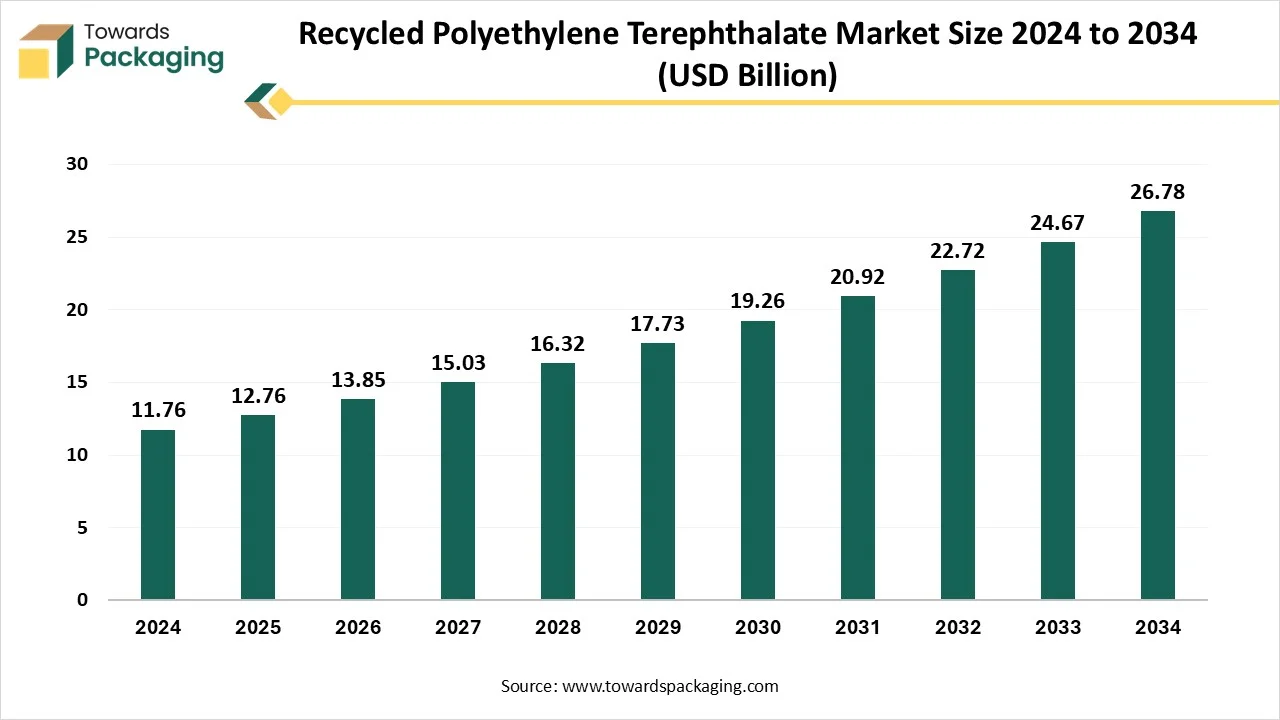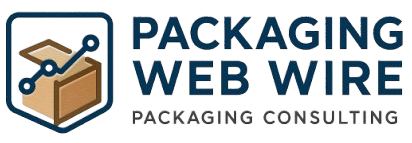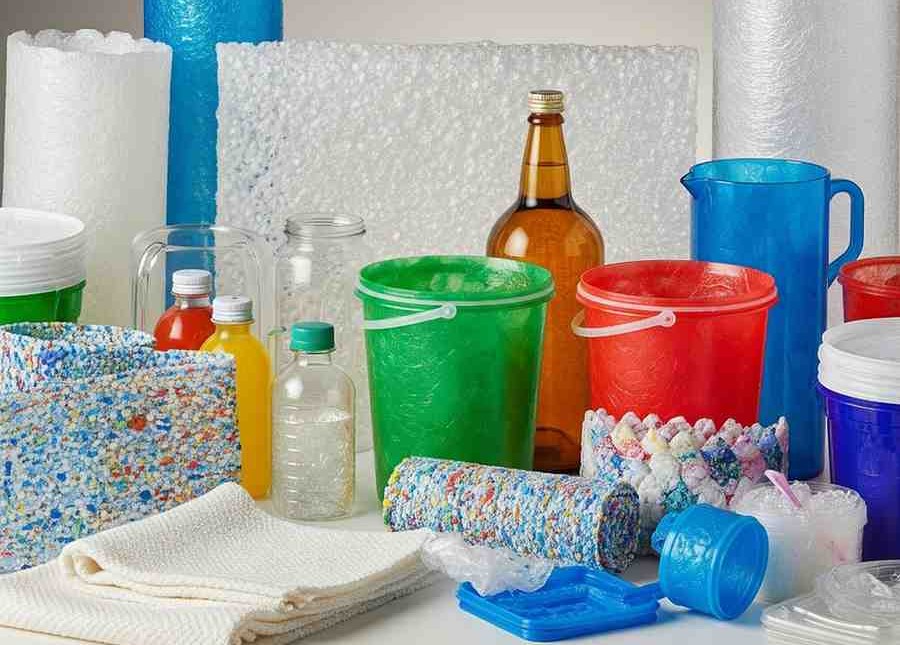Recycled Polyethylene Terephthalate, better known as rPET, is gaining immense traction in a world leaning towards sustainability. Derived from discarded PET bottles, food containers, and packaging waste, rPET plays a critical role in reducing plastic pollution, conserving resources, and closing the loop in the circular economy.
By converting used plastics into usable flakes or pellets through mechanical or chemical recycling, rPET is repurposed across industries—packaging, textiles, automotive, and beyond. The growth potential is promising, and the momentum is fueled by environmental awareness, technological innovations, and global policy shifts.

Market Size and Forecast: From Billion-Dollar Value to Robust Growth
The global rPET market was valued at USD 12.76 billion in 2025, and it is expected to surge to USD 26.78 billion by 2034. This marks a CAGR of 8.53% over the forecast period, driven by an increasing demand for sustainable solutions in packaging and textiles.
Notably, North America and Europe are projected to grow significantly due to stringent regulations and eco-conscious consumer bases, while Asia Pacific remains the largest player owing to its expansive manufacturing ecosystem and rising urbanization.
Invest in Our Premium Strategic Solution: https://www.towardspackaging.com/download-databook/5649
What’s Fueling the Market Growth?
1. Sustainable Packaging Demand
Environmental responsibility is becoming a corporate and consumer imperative. This is especially evident in the rise of rPET for food and beverage containers.
2. Technological Advancements
Innovations like enzymatic and solvent-based recycling are enabling higher-quality material recovery and true bottle-to-bottle recycling capabilities.
3. Government Regulations
Regulatory bodies such as the EU and FSSAI in India are implementing strict policies for recycled content usage in packaging, further pushing rPET adoption.
4. Corporate Commitments
Top brands like Coca-Cola, PepsiCo, and Unilever are pledging to include more rPET in their packaging, which amplifies demand and investment in recycling infrastructure.
Get All the Details in Our Solutions – Access Report Preview: https://www.towardspackaging.com/download-sample/5649
Key Market Segments and Insights
Bottles and Containers: Leading the Charge
PET bottles and containers dominated the rPET supply chain in 2025. Their high recyclability, abundant availability, and compatibility with food-grade standards make them ideal for closed-loop recycling systems.
Films and Sheets: Fastest Growing Source
Advanced rPET films and sheets are witnessing fast growth, with applications across packaging, automotive, and electronics. Their mechanical and thermal properties now rival virgin PET, making them a valuable resource in high-performance applications.
Clear vs. Colored Products
Clear rPET leads the market due to its aesthetic quality, ease of processing, and regulatory approval for food-contact applications. Meanwhile, colored rPET is growing rapidly in textiles, construction, and automotive sectors thanks to its cost-effectiveness and branding versatility.
If you have any questions, please feel free to contact us at sales@towardspackaging.com
End-Use Sectors
-
Fibers dominated in 2025, largely due to the booming textile sector’s shift to sustainable polyester alternatives.
-
Food and Beverage Containers emerged as the fastest-growing end-use, driven by consumer and regulatory pressures for circular packaging.
Regional Outlook
North America
Fueled by state-level recycling mandates and brand commitments, the U.S. and Canada are key growth engines. Technologies in AI-powered material recovery and closed-loop systems are enhancing recycling efficiency.
Europe
Thanks to stringent regulations such as the EU Plastics Strategy and Single-Use Plastics Directive, Europe is poised for steady growth. Mandatory recycling targets are accelerating rPET integration across industries.
Asia Pacific
Holding the largest market share in 2025, this region benefits from robust industrial activity, population growth, and increasing eco-awareness. Ongoing government initiatives support infrastructure improvements and sustainable packaging.
Innovations and Strategic Announcements
-
PolyCycl (India) unveiled a patented technology in January 2025 to convert hard-to-recycle plastics into fuel and food-grade polymers.
-
Borealis GmbH launched Borcycle M CWT120CL in March 2025, a flexible packaging-grade rLLDPE with 85% post-consumer recyclate.
-
Berry Global & Mars entered a partnership to transition candy jar packaging to 100% recycled plastic, showcasing industry-wide shifts.
Challenges to Overcome
Despite optimism, the industry faces hurdles like:
-
Inadequate recycling infrastructure in developing economies
-
Contamination issues due to poor waste segregation
-
Price competition from cheaper virgin PET, especially during low oil price periods
Addressing these bottlenecks through policy support, technological advancement, and consumer education will be vital.
How Artificial Intelligence Can Boost the rPET Industry
AI integration can redefine the rPET landscape. Vision systems powered by AI help with automated sorting and contaminant detection. AI also optimizes recycling plant operations, reduces downtime with predictive maintenance, and ensures smoother supply chain logistics. Additionally, AI-backed demand forecasting and consumer behavior analysis promote higher recycling rates and sustainability-driven marketing strategies.
FAQs
Q. What is rPET and why is it important?
Recycled Polyethylene Terephthalate (rPET) is a plastic derived from recycled PET products like water bottles and food containers. It reduces plastic waste and supports the circular economy by enabling sustainable reuse.
Q. What drives the growth of the rPET market?
Key drivers include increasing demand for sustainable packaging, stricter environmental regulations, technological advancements in recycling, and brand commitments to circular economy practices.
Q. Why are bottles and containers the leading source of rPET?
They are produced in large quantities, are easy to collect and recycle, and can meet food-grade quality standards, making them ideal for closed-loop recycling systems.
Q. Which region leads the rPET market and which is growing fastest?
Asia Pacific leads in terms of volume and market share. North America and Europe are witnessing rapid growth due to stricter policies and strong consumer preference for sustainable products.
Q. How does AI enhance the rPET industry?
AI improves recycling efficiency by enabling better sorting, reducing contamination, optimizing plant operations, enhancing supply chain visibility, and helping brands verify recycled content.
Source : https://www.towardspackaging.com/insights/recycled-polyethylene-terephthalate-market-sizing


